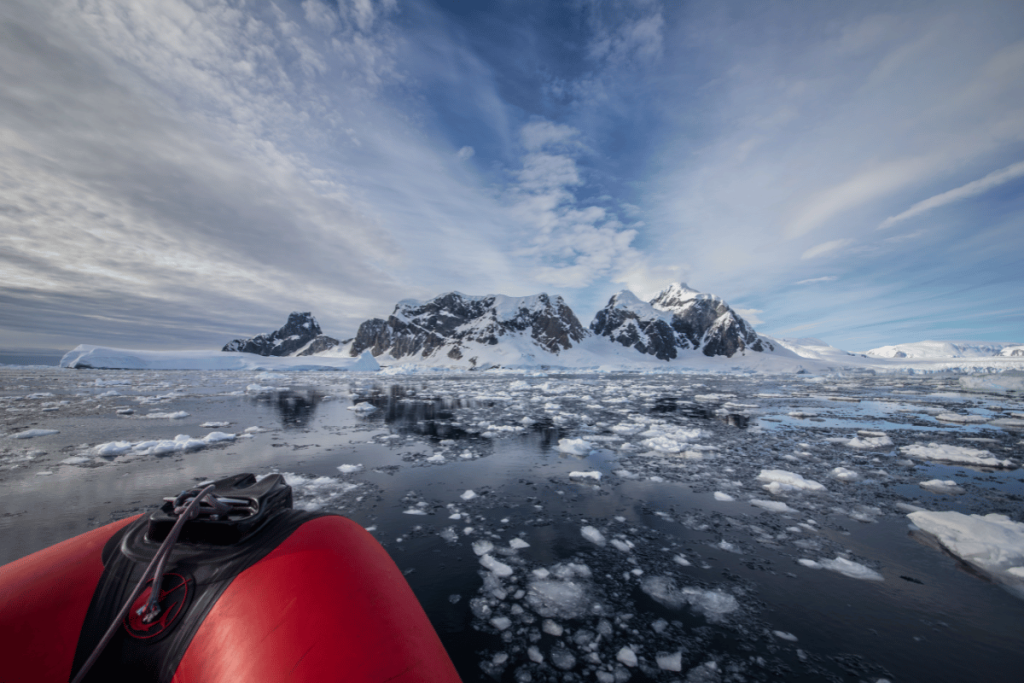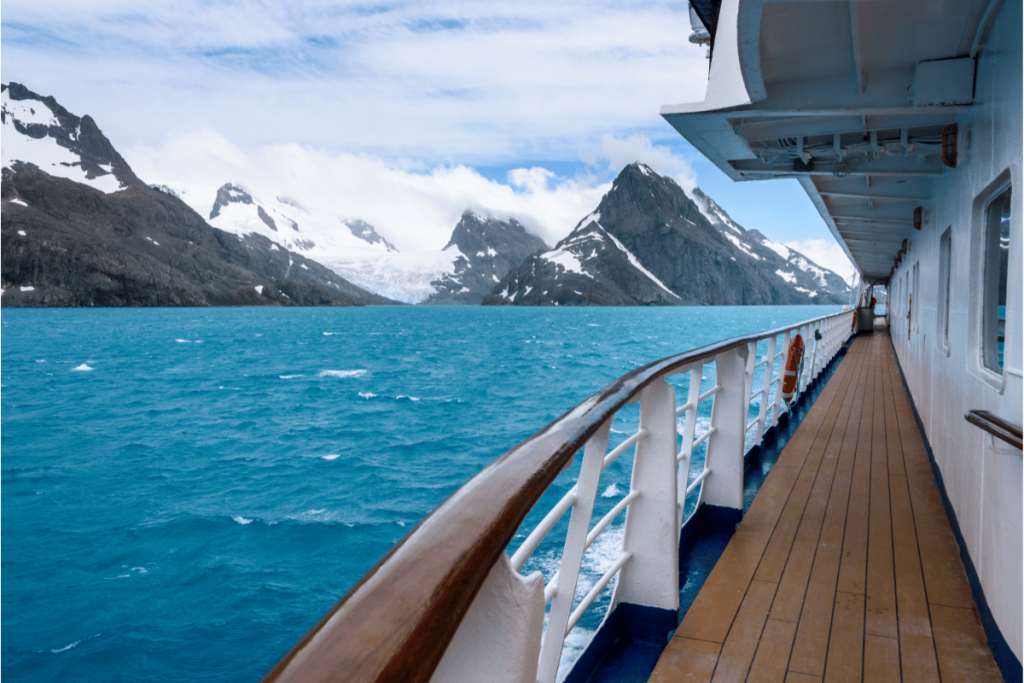Antarctica, the frozen continent at the end of the world, beckons adventurous souls with its stark beauty and unparalleled experiences. One such heart-pounding adventure is the polar plunge, a rite of passage for many visitors.
In this guide, we offer practical tips and insights based on advice from numerous travellers who’ve actually done polar plunges in Antarctica – to ensure you are fully prepared for a safe and unforgettable plunge.
- What does a polar plunge do to your body?
- Preparing for the Plunge
- How Cold is the Polar Plunge in Antarctica?
- Top Plunge Locations
- The Plunge Experience
- Safety and Health
- Post-Plunge Celebration
- Related Questions
- Are you able to wear neoprene socks for the polar plunge?
- How deep is the water near the plunge area? Do you need to know how to swim?
- Do you jump off the cruise ship or walk into the water from the shore?
- Do you need a wetsuit for a polar plunge?
- Is it safe to do a polar plunge if you don’t know how to swim?
- Do you need to remove facial and ear piercings before a polar plunge?
What does a polar plunge do to your body?
A polar plunge can have several effects on your body. The initial shock of the frigid water triggers the body’s natural fight-or-flight response, causing a rapid increase in heart rate and a surge of adrenaline. This cold immersion can lead to vasoconstriction, where blood vessels constrict, reducing blood flow to the skin’s surface to conserve heat.
However, this experience also encourages the release of endorphins, creating an exhilarating natural high and a sense of invigoration.
“A feeling of euphoria is common among open water swimmers when they get out”, Dr Heather Massey, a researcher at the University of Portsmouth’s Extreme Environments research group and a seasoned open water swimmer, told The Guardian.
“However”, she adds, “it’s really important that you dry and dress quickly. Delaying will only exacerbate any continued cooling as the water starts to evaporate from your skin – a very effective way of losing heat. We have to rewarm from the outside in. The cooling will continue until the warmth finally reaches the deep body. Only then will the body temperature start to rise”.
Over time, regular exposure to cold water may help enhance your body’s tolerance to cold, potentially improving immunity and circulation.
Additionally, a recent study conducted by researchers at Cambridge University discovered that cold-water swimming enthusiasts tend to exhibit increased levels of a specific protein associated with the formation of synapses, the vital connections between nerve cells. The underlying theory suggests that a higher concentration of this protein may play a role in reducing neural degeneration and potentially serve as a preventive measure against the onset of dementia.
Preparing for the Plunge
Plan your plunge during the austral summer when temperatures are slightly more forgiving. Prepare your body through cold exposure training and rely on your cruise’s experts to guide you safely through this heart-pounding adventure.
How Cold is the Polar Plunge in Antarctica?
Antarctic waters are unique, ranging from -1.5 to +2°C. The shock of the cold may be intense, but it’s an opportunity to connect with one of Earth’s most extreme environments.

Top Plunge Locations
Some of the best locations for a polar plunge include Deception Island, Neko Harbor, and Cuverville Island. These spots not only offer a heart-pounding plunge but also surround you with breathtaking scenery, adding to the magic of the experience.
The Plunge Experience
The ritual of a polar plunge involves a quick, shock-inducing dip into the frigid waters. Depending on the weather conditions that day, you will either jump into the water from the ship, from the zodiac, or walk into the water from the shore. Once you’ve taken the plunge, the initial shock gives way to an unparalleled sense of exhilaration.

Safety and Health
Polar plunges are not for everyone. Consult with a medical professional before taking the plunge to ensure you’re in good health. In case of cold-related issues, understand the emergency procedures in place. Safety always comes first when you’re participating in extreme cold activities in Antarctica.
Post-Plunge Celebration
After emerging from the icy waters, you’ll want to warm up quickly. There’s no better way to do so than with a cup of hot cocoa or mulled wine (and a bunch of towels), and believe us, it’s the best you’ll ever taste. These polar plunges leave you with incredible stories to share with fellow adventurers.
Related Questions
Are you able to wear neoprene socks for the polar plunge?
When preparing for the polar plunge in Antarctica, it’s essential to consider a few factors. Firstly, wearing neoprene socks or water shoes is highly recommended, especially if your plunge involves entering the water from the shore, as it can be rocky and challenging to walk barefoot. This is particularly important if you’re on a cruise like Hurtigruten.
Additionally, take into account the outfit you wear. If your cruise line utilizes safety belts for the plunge, opting for a one-piece bathing suit is a good choice since these belts can get wet and cold.
If you have specific health conditions, like cold urticaria and Raynaud’s, that make you more sensitive to cold, you can still participate with the right precautions. Neoprene socks will be a good idea but you should seek medical advice and consider additional measures to stay comfortable during the plunge.
How deep is the water near the plunge area? Do you need to know how to swim?
Different expeditions offer different plunge experiences, and it also depends on the sea conditions that day. Customers of the Ocean Victory Antarctica cruise reported that their Polar Plunge involved jumping off the ship, and that they had to wear a safety belt/harness which tethered them to a crew member. Some people opted to just dip in the water from the ship’s ladder, so no swimming was necessary.
Do you jump off the cruise ship or walk into the water from the shore?
Typically, this will be decided on the day of the plunge by the crew.
Do you need a wetsuit for a polar plunge?
The polar plunge experience is incredibly quick and exhilarating, typically lasting just around 30 seconds. Wearing a wetsuit may not be worth the hassle, as you’ll jump in, immediately exit, and get the chance to warm up afterward.
In some cases, ships offer shots or access to saunas for that purpose. Moreover, a wetsuit might not be the most practical choice, as it may not work efficiently in the extremely cold water, and you’ll remain wet longer, as you won’t have the opportunity to quickly dry off.
According to our research, many participants, including an older gentleman on one trip, simply wore swim trunks or a bathing suit and had a fantastic experience, enjoying the natural high that follows the plunge.
Ultimately, it’s all about personal comfort and preference, but most choose not to use a wetsuit for the polar plunge.
Is it safe to do a polar plunge if you don’t know how to swim?
Yes, it’s safe to do a polar plunge if you don’t know how to swim. Many cruise expeditions strap you into a harness if you’re jumping into the water from the ship, and most people only stay in the water for 30 seconds or less. Moreover, depending on the cruise and the conditions of the day, you might be walking into the water from the shore, rather than jumping in. In either case, knowing how to swim is not needed – it’s a speedy in and out operation!
Do you need to remove facial and ear piercings before a polar plunge?
Some people fear the cold water will make piercings burn their skin. We are not doctors, but having read numerous accounts from real people with piercings who did polar plunges, it is not necessary to remove facial or ear piercings. One participant wrote: “I’ve got a tonne of piercings in my face and everything was completely fine. Nothing to worry about.”




![Read more about the article How to Visit Antarctica [6 Different Ways to Visit]](https://polarguidebook.com/wp-content/uploads/2022/04/How-to-Visit-Antarctica-300x150.jpg)
![Read more about the article How Does Climate Change Impact Antarctica? How Can We Help in 2023? [According to an Expert]](https://polarguidebook.com/wp-content/uploads/2021/07/How-Climate-Change-Impacts-Antarctica-300x176.jpg)